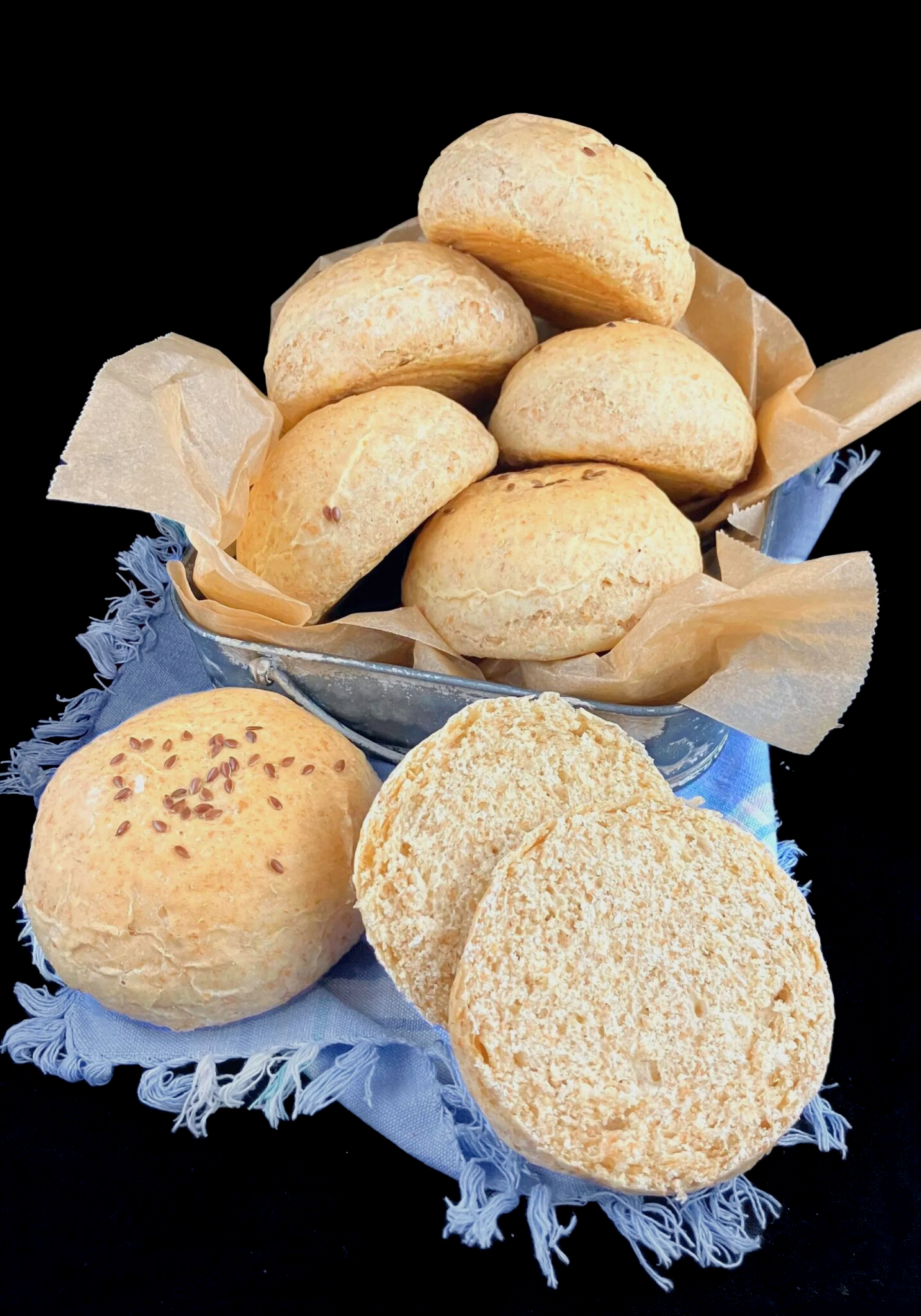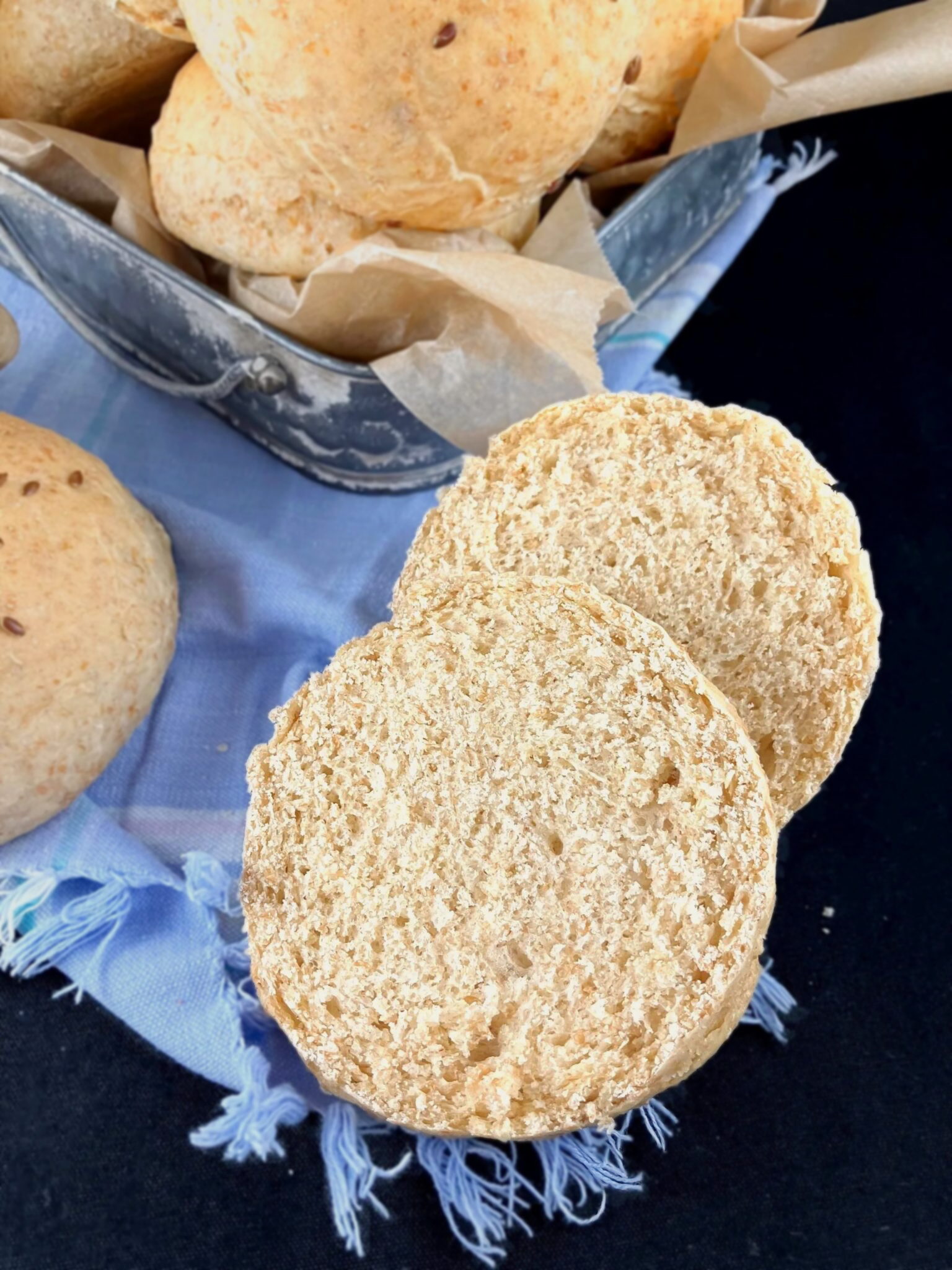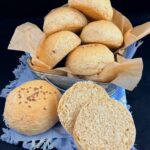Wholegrain Spelt and Oat Bread Buns
These delicious buns combine oats with both wholegrain and white spelt flour. Inspired by Sweden’s traditional havrebullar, they bring a touch of Nordic influence to your baking, creating soft buns that have a tender crumb and subtly wholesome flavour.
If you’re new to baking with spelt, and would like to learn more, my tutorial The Beginner’s Guide to Spelt Flour is a helpful resource.
Wholegrain spelt and oat bread buns
These wholegrain spelt and oat bread buns are soft, slightly nutty, and packed with wholesome flavour. Made with spelt flour, oats, and a touch of butter, they’re perfect for breakfast, lunch, or as a snack straight from the oven.
Baking with spelt flour requires patience, but the results are tender buns that taste incredible whether eaten fresh, toasted, or frozen for later.
Havrebullar: Sweden’s oat bread buns
Havrebullar, literally translated as oat buns, are a traditional Swedish breakfast bread bun made primarily with oats and often a mix of flours such as wheat or spelt. They are fairly dense with a slightly chewy texture from the oats.
The buns are usually shaped into small rounds and sometimes sprinkled with seeds or oats on top. Popular across Sweden, havrebullar are typically enjoyed at breakfast with butter and jam, or alongside coffee or tea as a snack. The oats add fibre and a gentle, wholesome flavour, making them both nutritious and satisfying.
My take on the Nordic classic buns is a little different. There are cooked oats, but I’ve also added butter into the dough. This creates a softer, lighter texture and a more tender crumb while still preserving the wholesome oat flavour.
Why spelt flour is different
I love spelt flour. Of course I do. Without it, I wouldn’t have this blog, full of so many wonderful ideas and recipes. For cakes, you can easily substitute it for all-purpose (plain) flour as it behaves in an identical manner. I even tested it to make sure, and the results of my spelt vs plain flour: which makes the best cupcake? makes interesting reading.
However, enriched spelt bread can a little more tricky and unpredictable, It has less gluten than regular flour, which affects mixing, proofing, and baking. For years, my loaves had blowouts or were lopsided because I rushed the process. Slowing down improved both appearance and texture.
Spelt, especially wholegrain spelt, is also denser than regular flour, so it often needs longer proofing times and lower baking temperatures to produce soft, tender bread. Everything about baking with spelt is done gradually, from kneading to shaping to the final bake.
If you would like to find out more about how to eliminate some of the common problems experienced with enriched spelt bread, check out my post Enriched Spelt Loaves: Tips, Troubleshooting & What to Expect.
Can I substitute the spelt flour?
Yes, of course. As mentioned above, it is easy to swap out. All of my bread recipes, including this one for wholegrain spelt and oat buns, are adapted so regular wheat flour can also be used without significantly affecting the final result. However, it’s the spelt flour that gives these buns their taste, soft texture and tender crumb.
This recipe uses a mixture of wholegrain and white spelt flour, which adds fibre and structure while keeping the buns soft. You can absolutely use all white spelt flour, which will produce a slightly lighter, softer crumb and a more delicate texture. The flavour will be milder, but the buns remain soft, fluffy.
Adding oats to bread
Oats are a highly nutritious whole grain and more than just a breakfast favourite. They are packed with soluble fibre, protein, vitamins, and minerals such as iron, magnesium, and B vitamins. This makes them a wholesome addition to bread, helping you feel full for longer, supporting healthy digestion, and contributing to overall heart health.
It’s very common to add raw or rolled oats directly to bread dough for texture and flavour. In this recipe, however, the oats are cooked first, which makes them creamier, easier to incorporate, and helps them retain moisture. This not only keeps the buns soft for longer but also slightly improves the bread’s shelf life.
What are linseeds?
A light sprinkle of linseeds before baking adds subtle crunch, extra fibre, and heart-healthy omega-3 fatty acids.
Linseeds are the small, brown or golden seeds of the flax plant (Linum usitatissimum), one of the oldest cultivated crops in the world. The plant is universally called flax, but in the UK, Europe, and Australia the seeds are traditionally called linseeds, a name derived from the Latin word linum for flax. This terminology has persisted in baking and agricultural contexts for centuries.
Flax is grown in temperate regions, including Canada, Russia, and parts of Europe, for both its seeds and fibres, which are used to make linen. The plant produces slender blue flowers, and the seeds are harvested when the pods are ripe and dried.
Brushing the buns with a little water before sprinkling helps the seeds stick and gives a gentle shine to the finished loaf. Linseeds also enhance the rustic, homemade appearance of the buns, making them visually appealing.
If you don’t have linseeds, alternatives such as sesame seeds, sunflower seeds, pumpkin seeds, or even rolled oats work well, providing a similar decorative and nutritious effect.
Additions for the dough
Just like the sprinkling on top, you can adapt the bread dough any way you like, too. This time, I didn’t include any seeds or additional ingredients in the dough, but you could easily make them your own. Some alternative options include:
- Sunflower seeds: add crunch and subtle flavour
- Pumpkin seeds: boost colour, texture, and nutrients
- Chopped nuts: almonds, walnuts, or pecans for richness
- Dried fruit: raisins, cranberries, or chopped dates for sweetness
- Herbs or spices: rosemary, thyme, or cinnamon for savoury or sweet notes
These additions enhance flavour and texture, while letting you customise the buns to your taste and create unique batches.
Wholegrain Spelt and Oat Bread Buns
Ingredients
- 250ml (1 cup) water
- 65g (¾ cup) oats
- 250ml (1 cup) milk
- 7g (2¼ tsp) yeast (see note 2)
- 50g (3½ tbs) butter
- 2 tsp salt
- 1 tbsp sugar
- 200g (1⅔ cups) wholegrain spelt flour (see note 1)
- 300 to 400g (2½ - 3⅓ cups) white spelt flour (see note 1)
- linseeds (to sprinkle)
Instructions
- Place the water and oats in a pan and gently heat until there is no water left and the mixture resembles porridge. Set aside.
- Gently heat the milk in the microwave until just lukewarm (around 37–40°C / 100–105°F). Stir in the butter (it will soften nicely).
- Pour both the oat and milk mixtures into a stand mixer bowl.
- Add all of the wholegrain flour and 300g (2½ cups) of the white flour. Mix until everything is well combined.
- Gradually add extra flour as needed one tablespoon at a time, allowing it to incorporate fully before adding more. You may not need the full amount stated, or you could need more. Be careful not to add too much, as this will make the bread dense.
- After a few minutes, the dough will start to pull away from the sides of the bowl. You may notice your machine working a little harder (mine starts to make a clumping sound). The dough will still be sticky and will slip easily from the paddle.
- Using a spatula, scrape the dough from the paddle. Add a little more flour and continue kneading until the dough pulls completely away from the sides of the bowl and most of the bottom. It will no longer drip from the paddle but should come away easily when pulled. The dough should feel tacky, but not stick to your fingers.
- Cover the dough and leave it to proof in a warm place until it has doubled in size, usually 60–90 minutes.
- Knock back the dough on a lightly floured surface and form it into a rough ball.
- Divide the dough into approximately 12 pieces.
- Form them into balls and place them on a large baking tray lined with baking paper, leaving space between each bun.
- Brush the tops with a little water and sprinkle with linseeds, or any other seeds you like (rolled oats also work well).
- Cover the buns once more and let them rest for 10–15 minutes while you preheat the oven to 175°C (350°F).
- Bake in the lower part of the oven for around 20 minutes, until the tops are lightly browned. The buns are ready when the bottoms sound hollow when tapped.
- Allow to cool slightly, but enjoy one warm straight from the oven for the best flavour. The buns will last one or two days at room temperature, are excellent toasted, and they also freeze very well.
Notes
- You can use all-purpose (plain) flour instead of spelt flour. Just do a straight swap.
- In Sweden we have something called dried yeast. It is used both in warm liquid to proof and also added directly to flour. I am aware that the US has two options for dried yeast, and I believe instant yeast is the most similar to our dried yeast.







